 Is the Old School Effective?
Is the Old School Effective?
In Learning Can Be Painful – Part One, I didn’t get into my experiences in music school with my clarinet teacher. Nor did I delve into my experiences learning the craft of painting from my father. These, and many of the examples I describe in Part One and those contained in the evocative blog about Circle in the Square, are examples of what used to be called “old school” teaching. There is a difference, I believe, between teaching someone who intends to do an artistic discipline for a living, versus those who are doing it for fun or as an avocation. The first thing I ask a student of acting or painting is whether they want to do this as a career or if they just want to get deeper into, and better at, expressing themselves. The old school approach is about getting to breakthrough results as rapidly as possible, to build advanced skills. It is not for the light of heart. It is intense and requires superhuman effort.
Either way, the learning process must be respected. This consists of a number of steps. First listening, then comprehending, then understanding. Then comes practice and repetition. Then the information must be integrated and reconciled with prior learning and preconceptions. And eventually, after months or years of experimentation and implementation comes assimilation, where the information becomes second nature. It becomes part of who you are as an artist.
There is a place for old school confrontation, which is often includes intimidation and brow beating. The old school theory goes that we only can learn new information as a result of an emotional catharsis, where we discover for ourselves the importance and meaning of the material at hand. A good teacher is someone who facilitates and possibly orchestrates these epiphanies. I can lecture til I’m blue in the face but ultimately the student must discover the material through an organic process. As I said above, that process can be painful, but not always.
My dad (Joseph Maniscalco) didn’t want to waste his or my time “molly coddling” me. He was in favor of accelerated learning. Why? Because there is simply so much to learn about painting, the demand for real progress is urgent and important. It would be physically impossible for me to assimilate the information over a period of several years. I needed to be excellent right out of the gate. I was in it to make a living and if I didn’t do it in a certain envelope of time I would miss my opportunity. Check out Eminem’s Lose Yourself, in 8 mile.
My clarinet teacher, Paul Schaller, had only four years with me in college to get all his wisdom and experience into me. He would say, “the way you’re playing now you might make enough money to afford two hotdogs a week.” Yes, he measured my progress in hotdogs! It was humiliating but effective. I’m pretty sure if I had not been sexually assaulted at 14, I would probably be principal Clarinet in a major orchestra. But my unresolved issues stood like a wall between me and my success. We all have “what ifs” in our lives. The key is to keep going. And that is what this blog is really about.
Suffice it to say there is a lot of pressure on both the master and the apprentice to “make it” in the arts. My teaching approach to a
n aspiring amateur (one who works for the love of doing) is entirely different than for an aspiring professional.
It’s important to note that I always frame my teaching as optional. “This is what works for me.” I do not present my methods as cardinal knowledge. It is never “the” truth. Much of what I learned from my father, and others since he died, is based on accepted practice, that is, knowledge past down over time. For instance, I only discovered that all accents must be warm a few years ago. I developed my process of building an envelope in my drawings by reading several books about drawing.
My learning process is not casual or gentle. It is intensely focused and ongoing. At age sixty, I’m still learning and discovering new things about writing and painting and composing and teaching every day. Why? Because I know from experience that stagnation will show up in my work. And my work is not just my living, it has become my mission.
I have a lot yet to say with my art and know I have to be in it 100% if I’m going to accomplish my goals. The life clock is ticking and I want to be able to say at the end that I put a dent in this world. I made my mark. Not that I got rich or became famous, but that I made a living. That is to say, I did what I loved and moved people enough to support me and my family in a fairly comfortable way so that I could continue to do what I loved until I chose not to. What else could a person want from a career?
When my dad found out he had Alzheimer’s, he put down his brushes and intentionally ended his career on the spot. I don’t know what I will do when I’m at that point. But I do know I will have learned something from his example, which will inform my decision. That is what learning is all about.


 Would you like 20% Off any product or service on ManiscalcoGallery.com?
Would you like 20% Off any product or service on ManiscalcoGallery.com?